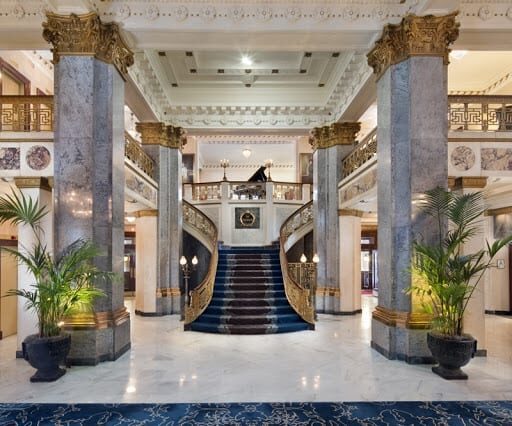Dining, Entertainment, Attractions & Lodging: Louisville, Kentucky
Not every city has a hotel that can say it was an inspiration for The Great Gatsby, or has rooms with hidden doors and secret passageways that were used by bootlegger Al Capone, or has a rathskeller with medieval architecture that hosted the USO during the war. But the Seelbach Hilton Louisville, built in 1905 in the heart of downtown Louisville’s business and entertainment district, now directly across from Fourth Street Live Entertainment Complex and seven blocks from the KICC, can.
The Seelbach was the manifestation of the American Dream for immigrant brothers Louis and Otto Seelbach, two native Bavarians who came to the city in the mid-19th century. In 1905, the “Seelbach Hotel” celebrated its grand opening with 25,000 visitors. Designed by W.J. Dodd and F.M. Andrews, the Seelbach boasted a lavish, turn-of-the century Beaux-Arts Baroque architectural style, embodying the “Old World” opulence of Viennese and Parisian hotels. Equally grand, the hotel interiors featured a lobby furnished with marble from Italy, Switzerland and the U.S., along with mahogany and bronze in a classic Renaissance style, and a vaulted dome of 800 glass panes atop the space. Arthur Thomas, the most famous Indian painter in the world, decorated the lobby with huge mural paintings of pioneer scenes from Kentucky’s history. The hotel has changed hands numerous times, with more than $50 million being spent in renovations over the years, including adding an 18,500 sq.ft. conference center in 1990 and taking the Hilton name and management in 2007.
During the Roaring Twenties, The Seelbach was considered the most glamorous spot for cards and leisure. Situated in the center of bourbon and whiskey country, the hotel attracted infamous underworld kingpins and gangsters during Prohibition including Lucky Luciano, “Beer Baron of the Bronx” Dutch Schultz, and the legendary Al Capone. According to the hotel’s website, Capone often dined in The Oakroom, where he would play cards in a small alcove within the venue. The gangster’s favorite room has two hidden doors behind special panels that led directly to a few secret passageways. It even still displays the large mirror Capone sent from Chicago so that he could watch his back. Cincinnati mobster and “King of the Bootleggers” George Remus also spent time at the Seelbach, where he became friends with writer F. Scott Fitzgerald. Fitzgerald visited the hotel while training for the U.S. Army at nearby Camp Taylor. In 1925, F. Scott Fitzgerald immortalized both Remus and the hotel in his novel, The Great Gatsby. Remus served as the inspiration for the novel’s title character, Jay Gatsby. Fitzgerald used the Seelbach and its Grand Ballroom as the inspiration for the novel’s wedding scene.
The Rathskeller, the only room in existence made of Rookwood Pottery, has a red-tinted, terracotta ceiling, with columns ringed by Rookwood-Pottery pelicans—a sign of good luck. Tile designs on the Rathskeller’s walls depict walled cities in the Rhenish region of Germany, where the Seelbach’s founders, Otto and Louis Seelbach, were born. During the war, many servicemen came to the Rathskeller as the USO provided the entertainment.
The Oakroom has celebrated an unparalleled tradition of excellence since it opened in 1907. In 1998, The Oakroom received Kentucky’s first AAA Five Diamond Restaurant rating and, for 14 years, has remained the only restaurant in the state with such a treasured distinction. The Oakroom also maintains the largest wine cellar in the region with wines from the legendary vineyards of Central Europe to the small artisanal producers of Sonoma County and the Finger Lakes region.
Listed on the National Register of Historic Places, The Seelbach Hilton Louisville has been a member of Historic Hotels of America since 2015.






























